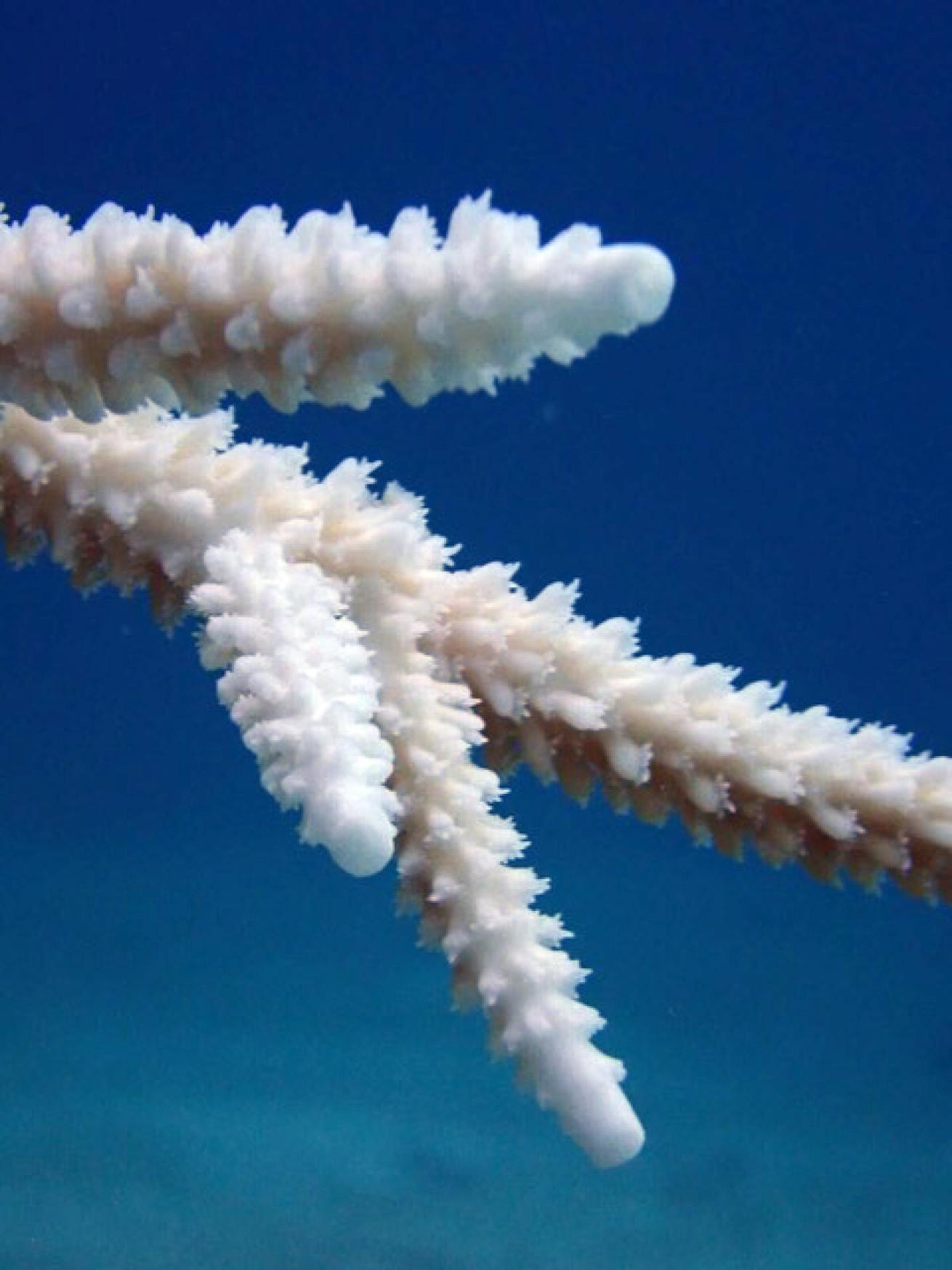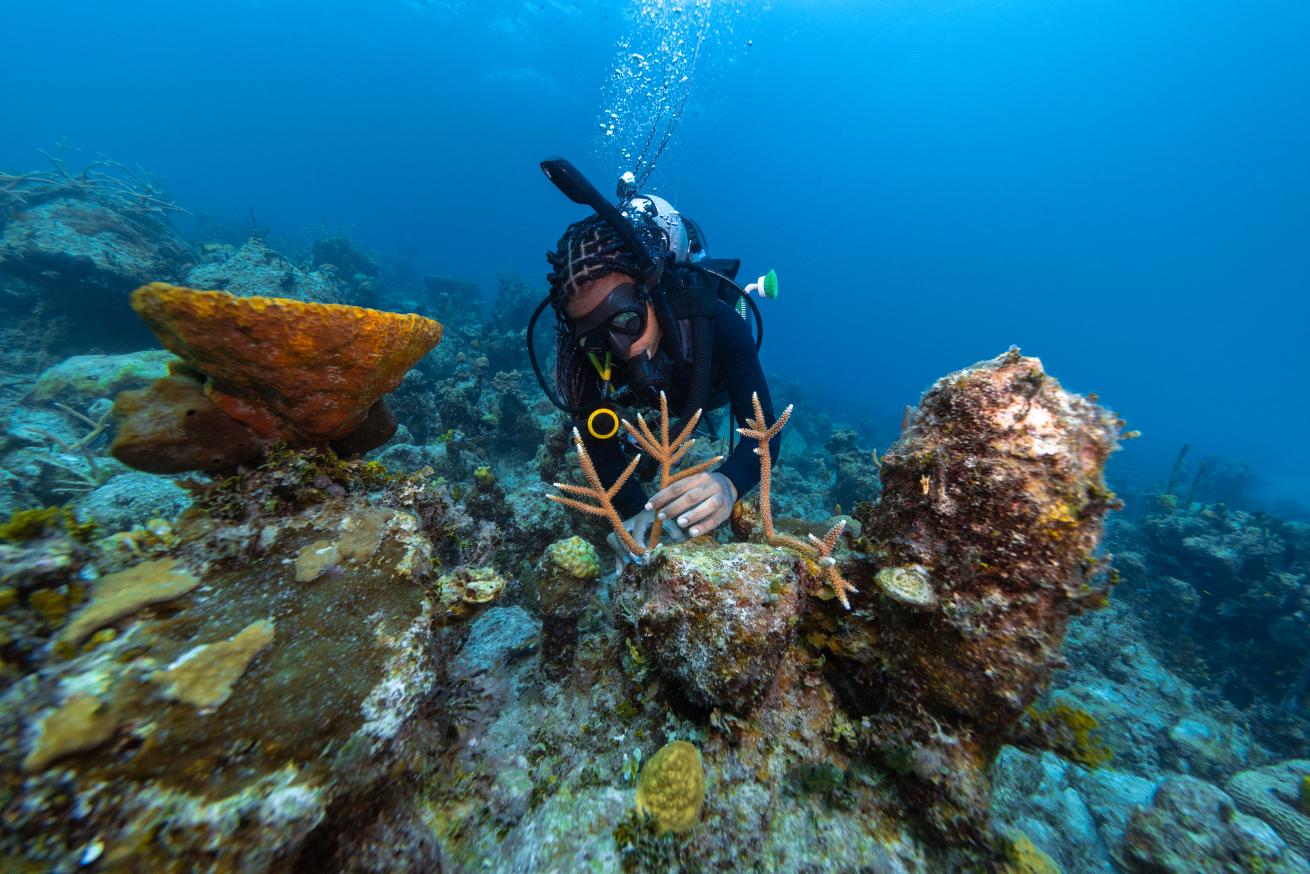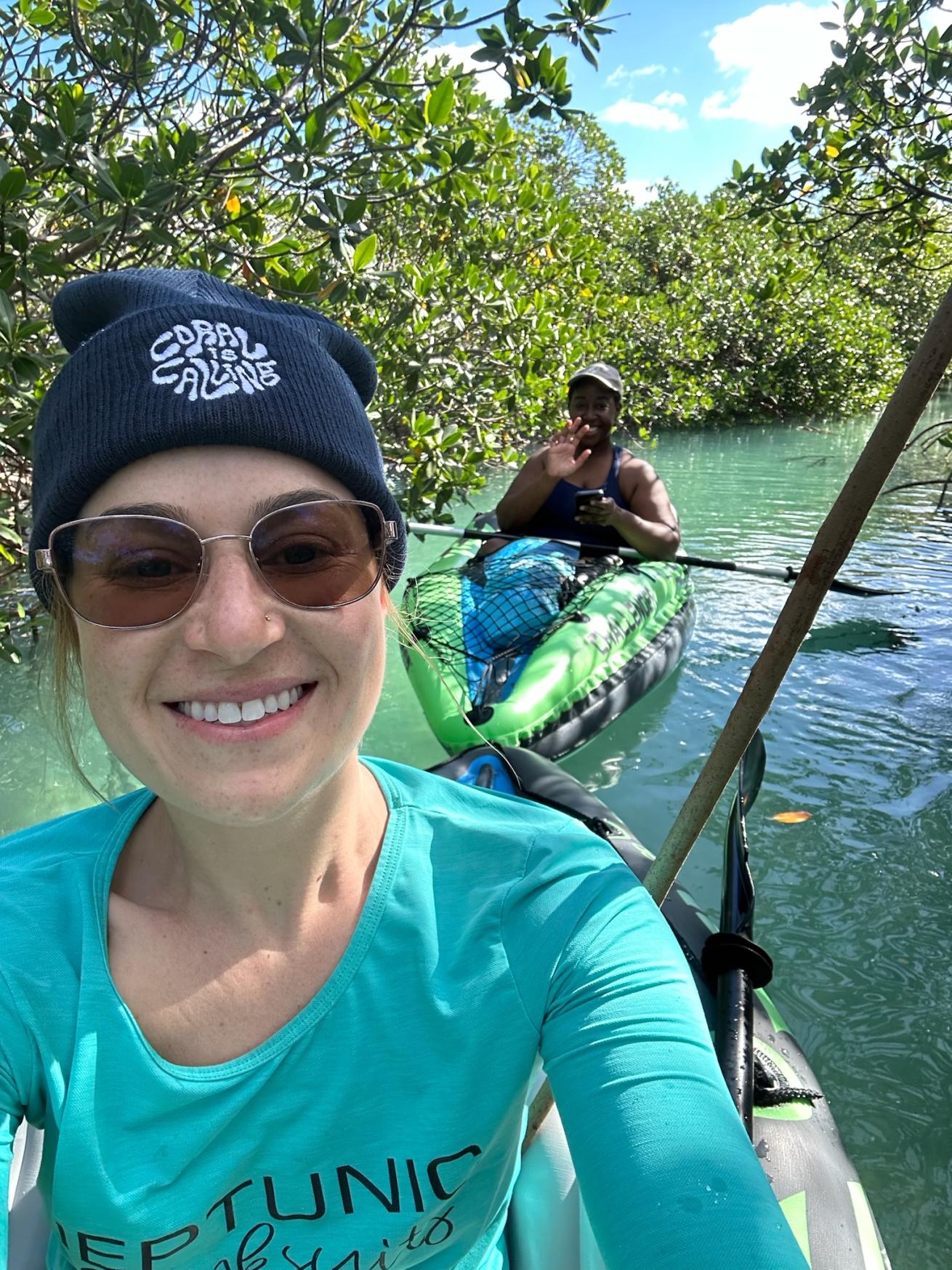Fighting to Save the Caribbean's Coral Reefs

Inka CresswellThe Reef Rescue Network operates 50 coral nurseries in three countries. This nursery, off Nassau, is watched over by an installation titled “Ocean Atlas” by Jason deCaires Taylor. The sculpture, sitting in 15 feet of water, depicts a Bahamian girl holding up the weight of the ocean.
In 1959 Dick Birch climbed to the top of an invasive casuarina tree and surveyed his newly acquired land in Small Hope, Andros Island, Bahamas. From this vantage point, he could envision the underwater canyon below, nicknamed the “Tongue of the Ocean,” and plunging to 6000 feet just 2 miles from the shoreline of the property, begging to be explored.
Together with his wife and eight children, he began to build the (self-proclaimed) first dive resort in the Caribbean, and Small Hope Bay Lodge was born. Today, the rustic 20-room lodge continues to cater to divers and fishers who appreciate a sense of community.
Within minutes of my arrival, I walk through the airy outdoor patio laced with string lights and I’m drawn into the warm atmosphere that Birch has nourished for decades.
I feel as if I’ve walked into a family reunion. Divers mingle freely and sit at communal tables. Tales from the day’s dives float through the air as people kick back their feet and settle in with a strong drink. The staff spends most of their days among the guests—many of whom are return visitors—and traditions dating back 64 years can be found in every element of the lodge.
There is a daily viewing of underwater videos collected by the guides, a formal send-off and award ceremony for each guest as they depart, and a colorful and unofficial uniform of wax-printed batik fabric called Androsia, worn by staff and guests alike. The laid-back ambiance makes me start to forget that I’m here on assignment for a Scuba Diving magazine story as I am slowly sucked into the surrounding calm of Andros.
Cause for Hope
The Bahamas is made up of about 700 islands, the largest of which is Andros, and it boasts the third-longest barrier reef in the world. The reef alone lures divers to the islands, but the area also has highly sought-after cave and cavern diving, as well as oceanic and inland blue holes to explore. The Tongue of the Ocean, a deep-water region that runs between Andros and New Providence, is one of Andros’ claims to fame, as well as shark diving.
Before I can explore caves or shark zones, I scope out the nearby reefs. I flew into Andros with a newly acquired PADI Reef Rescue Diver specialty certification, and I planned to volunteer my skills in coral nursery maintenance. I walk down the windy wooden pier to the overwater dive deck, where a boat awaits me to embark on my mission for the week.
Courtesy, Yente CoetzeeThe author uses a metal brush to clean algae from the PVC coral trees to prevent overgrowth and allow the coral fragments to grow to their full potential.
Just offshore, at two of the 100+ dive sites surrounding the resort, there are large coral nurseries waiting for my arrival. These swimmable purpose-made zones are dotted with submerged “trees” made of PVC pipe and line. One end of each tree is tethered to the seafloor, and a buoy holds up the top end.
Tiny fragments of fast-growing and critically endangered staghorn and elkhorn coral (Acropora cervicornis and Acropora palmata) are attached to each “branch” to grow and eventually be outplanted to reestablish healthy colonies. These trees carry the hope that coral reefs in the Bahamas and beyond can be restored to their former glory.
As I fin between these floating nurseries, I pass colonies surrounding the trees in various stages of stress. In the summer of 2023, social media was flooded with images of Caribbean coral reefs turning white as snow. Warm water had engulfed the area and stressed these corals, prompting them to eject their zooxanthellae–the symbiotic algae that live in their tissues and give them their vibrant colors.

Couresty, Perry Institute for Marine SciencesBleached coral appears white because the colorful photosynthetic algae that lives in their tissues are ejected when the colony is stressed.
This stress response, called bleaching, is a symptom of our changing climate and something that younger generations of scuba divers have become all too familiar with. The zooxanthellae provide corals with around 90% of their nutrients, and without them, corals starve. If the warm water subsides relatively quickly, corals have a chance to recover. But bleaching that is prolonged will kill a reef.
It’s January of 2024 now, and the corals at the Small Hope Bay Lodge nurseries have miraculously rebounded and survived the mass bleaching. Other nurseries on New Providence and Eleuthera Islands sustained longer warming periods and were not so lucky.
Related Reading: How to Dive Maui Without Breaking the Bank
Licensed to Scrub
In my certification course with the Reef Rescue Network (the coral conservation arm of the environmental non-profit Perry Institute for Marine Science), we discussed how coral reefs buffer storms, support local fisheries and livelihoods and underpin a beautiful and vast web of life.
I learned that there are ongoing efforts to help reefs recover from bleaching and coral disease by raising resilient corals in underwater nurseries and outplanting them to struggling reefs. In addition, scientists are creating gene banks to preserve genetic diversity and to have an emergency source to draw from if a coral species is unable to survive on its own in the face of warming oceans.
Courtesy, Yente CoetzeeCoral fragments are extremely susceptible to algal overgrowth, which is why PADI Reef Rescue divers must visit and clean the trees weekly.
At this nursery site, called “Jeff’s Ladder,” 10 coral trees hang in the water column. Divers come here weekly to use metal brushes and plastic scrubbers to remove the soft green algae that quickly colonize any available substrate. If not removed, this algae is the kiss of death for the vulnerable coral frags that hang from the trees. But when cared for, these staghorn and elkhorn coral frags can grow up to 2 inches per year until they are large enough to be outplanted on the reef.
Together with my guide Yente, I begin meticulously scraping the fuzzy algae from every inch of the trees. The work is both taxing and satisfying, and it requires a high degree of focus to maintain buoyancy in the light current and avoid touching any of the frags while cleaning.
Watching the plumes of green algae dust dissipate into the water column as I drag my metal brush back and forth across the slimy PVC pipes is extremely gratifying, and after 30 minutes or so, my hand is cramping rapidly, but the trees are sparkling clean.

Courtesy, Perry Institute for Marine SciencesA PADI Reef Rescue diver uses epoxy to affix larger coral fragments to the reef.
As an additional reward, Yente takes me on a tour of the shallow reef, stopping to point to a group of foot-long branching staghorn bits that have been pasted to a piece of dead coral. While the site looks like Frankenstein’s reef, the knowledge that these fragments were outplanted most recently is heartwarming. They have grown tremendously in nine months, and their branches have become interwoven. As they form a new colony, they are also growing hope.
Building Back
After resurfacing and drying off, I eagerly share my underwater adventures with fellow guests at the lodge, only to realize that many are unaware of the existence of these underwater nurseries. However, as I describe the process of becoming a PADI Reef Rescue Diver, the guests are excited at the prospect of being able to help just as I did.
This certification not only empowers divers to contribute on Andros Island, but it extends everywhere the Reef Rescue Network operates—Aruba, Saint Lucia, and 12 islands in The Bahamas (Andros, Long Island, the Exumas, the Abacos, Eleuthera, Harbour Island, New Providence, Rose Island, Cat Island, Grand Bahama, San Salvador and Bimini).
Related Reading: A Liveaboard Trip of A Lifetime
This certification helped me live a tenet of ecotourism, in which travel is woven into local conservation and sustainability efforts. The goals of ecotourism deeply resonate with me, as it embodies a meaningful way to give back and address the ocean's challenges, which can seem overwhelming.
As divers, we often have a heightened awareness of ocean health, and this offers us a unique opportunity to wield our skills for a positive impact. While individual efforts like cleaning coral trees on vacation may not solve every ocean issue, there's immense value in individuals connecting with global conservation groups and initiatives. By supporting local endeavors worldwide, we can foster a global network of individuals committed to preserving our oceans.

Ariella SimkeThe author and her new friend, Jasmond, kayak through a mangrove forest on Andros Island. There are three species of mangroves in the Bahamas: red mangroves, black mangroves and white mangroves. These trees provide essential nursery habitat for many species.
On my final day in Andros, I hike down the beach, through a marsh where mangroves grow, to embark on a kayak journey with a new friend, Jasmond, who moved to Andros to work as the first program coordinator for the Small Hope Bay Foundation, a nonprofit started by the Small Hope Bay Lodge that focuses on conservation initiatives.
Drifting away from the beach, we paddle into the dense forest and slowly navigate channels between the mangrove’s leggy roots. The wind is strong, and our surroundings are serene. We listen to the ocean lapping softly against the sugary sand and the wind racing over the thickets. Reflecting amidst these tranquil surroundings, I ask about her experience working in conservation in the Bahamas and if she ever feels it is hopeless.
Her response strikes a chord in me: "We have to focus on the positive." In the face of an enormous and ongoing problem, her simple yet profound sentiment perfectly encapsulates the essence of conservation work.
In my opinion, awareness without action is useless. Only by shifting our focus from doom and gloom to the positive can we keep moving toward our collective goal of improving our relationship with the ocean.
While I may not have a career in conservation, I care deeply about the health of our ocean. Becoming a PADI Reef Rescue diver gave me one more reason to keep the hope alive in my own heart while supporting those like Jasmond who have committed their careers to the cause. I can’t imagine anything more positive than that.










